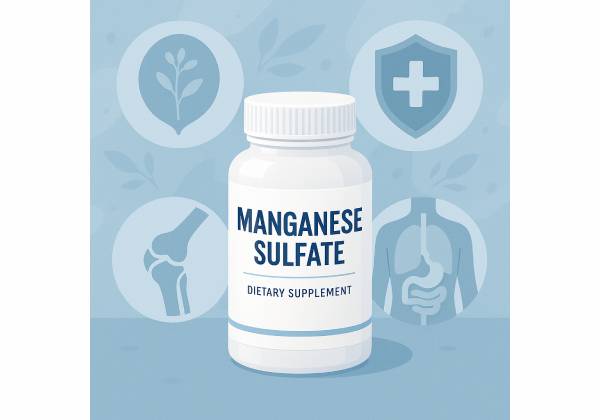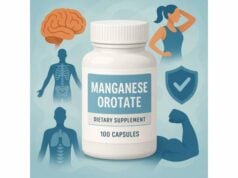
Manganese sulfate is one of the most common, highly soluble salts used to supply the essential trace mineral manganese. Your body needs manganese in small amounts to run antioxidant enzymes, support normal bone formation, and help metabolize carbohydrates, amino acids, and cholesterol. Because manganese is found in whole grains, legumes, nuts, seeds, tea, and leafy greens, most people meet their needs from food alone. Still, some turn to manganese sulfate in multivitamins or targeted supplements—especially when diets are restricted, soil content is low, or certain medications increase demand. The key is scale: a little can help close a gap, but more is not better. Intake above safe levels can accumulate, particularly when liver or biliary function is impaired, raising the risk of neurological side effects. This guide takes a balanced, evidence-informed look at manganese sulfate: what it does (and doesn’t) do, how it compares with other forms, how to take it wisely, what affects absorption, who should avoid it, and what the research actually supports.
Essential Insights
- Supports manganese-dependent enzymes for antioxidant defense and bone formation.
- Typical supplemental dose ranges 0.5–3 mg/day of elemental manganese from manganese sulfate.
- Do not exceed total daily intake of ~8 mg/day from all sources unless medically supervised.
- Separate from tetracycline or fluoroquinolone antibiotics by at least several hours.
- Avoid use in children, during pregnancy without medical advice, and in anyone with liver or biliary disease.
Table of Contents
- What is manganese sulfate?
- Does it work and for what?
- How much to take and when
- What affects absorption and results
- Mistakes, interactions, and who should avoid
- Evidence snapshot and practical verdict
What is manganese sulfate?
Manganese sulfate is an inorganic manganese salt, most often provided as the monohydrate. In supplements, you’ll usually see it in multivitamins or mineral complexes because it dissolves easily in water and delivers manganese ions efficiently in the small intestine. Labels typically list elemental manganese—the actual amount of manganese your body can use—rather than the total weight of the salt. This matters: 10 mg of manganese sulfate contains less elemental manganese than 10 mg of pure manganese metal would. When comparing products, always use the elemental number.
In human biology, manganese is a cofactor for several enzymes. A standout is mitochondrial superoxide dismutase (MnSOD), the cell’s frontline defense against oxidative stress. Others include enzymes involved in connective tissue formation and bone mineralization (such as glycosyltransferases) and enzymes that help break down macronutrients. Without enough manganese, these enzyme systems slow, potentially affecting energy metabolism, cartilage integrity, and the body’s handling of oxidative byproducts.
Dietary manganese is widely available: whole grains, oats, brown rice, pecans, hazelnuts, walnuts, chickpeas, soy foods, tea, and leafy greens are major contributors. In most regions, adults ingest roughly 2–6 mg/day from food. Because manganese is tightly regulated—absorption falls when intake is high and rises when intake is low—deficiency is rare in healthy adults consuming mixed diets. That’s why manganese sulfate is commonly used to complement, not replace, a diet, and why conservative supplemental amounts are appropriate for most people.
How does manganese sulfate compare with other forms? Soluble salts (sulfate, chloride) typically release manganese readily for absorption; chelates (bisglycinate, picolinate) are marketed for gentler GI tolerance or different absorption profiles. In practice, the total amount you take, your iron status, competition from other minerals, and timing with meals influence outcomes more than the specific salt, as long as it’s a reputable product with accurate labeling.
Manganese homeostasis relies on a functioning hepatobiliary system. After absorption, the liver packages manganese for excretion into bile; most excess leaves via the feces. When biliary flow is reduced or liver function is compromised, manganese can accumulate. That’s why supplement decisions should consider medical history first, dose second, and form third.
Finally, outside dietary supplements, manganese sulfate is widely used in agriculture and industry. That has no bearing on supplement quality per se—but underscores why sourcing and third-party testing matter. Choose brands that disclose elemental content, batch testing, and appropriate cautions for vulnerable groups.
Does it work and for what?
Core role, not cure-all. Manganese sulfate supports enzyme systems that you already depend on daily. That means the benefits are clearest when intake is marginal, demand is increased, or competing nutrients are out of balance. It is not a stimulant, a standalone joint pain remedy, or a shortcut to faster metabolism. Expect subtle, supportive effects tied to adequate—not excessive—intake.
Antioxidant defense. MnSOD detoxifies superoxide radicals in mitochondria. Keeping manganese in the adequate range supports this enzyme’s capacity. You won’t “feel” MnSOD working; it’s a background process, like routine maintenance for your cells. But in contexts of high metabolic activity—or when the diet is low in whole plant foods—ensuring sufficient manganese helps maintain resilience against oxidative stress.
Bone and connective tissue. Manganese participates in the formation of proteoglycans, essential for cartilage and bone matrix. Combined with vitamin D, calcium, magnesium, zinc, and vitamin K, adequate manganese is one link in the chain for bone maintenance. If a multivitamin-mineral provides 1–3 mg/day of manganese (often as manganese sulfate), it can help round out intake for people who rarely eat nuts, legumes, or whole grains.
Energy and macronutrient metabolism. Several manganese-dependent enzymes handle steps in carbohydrate and cholesterol metabolism. Supplementing to correct a gap may support normal metabolic pathways—particularly in diets low in manganese-rich foods. But manganese is not a “fat burner.” Any changes in energy levels from correcting a shortage will be modest and indirect.
Neurological health—proportionality matters. Manganese is required for brain antioxidant systems, yet accumulation above safe levels is linked to neurological symptoms. This is the classic U-shaped curve: too little is problematic, too much is also problematic. Responsible use centers on staying near dietary adequacy, and below established safe levels (see dosage section). For most adults eating balanced diets, a low supplemental dose is enough—or no supplement at all.
Who might benefit?
- People with restricted diets (e.g., very low whole-grain or legume intake) who still want full coverage of trace minerals.
- Those taking high-dose iron or calcium long term, which can lower manganese absorption; small manganese amounts in a multi may help maintain balance.
- Individuals guided by a clinician after tests suggest low status or when tube feeds/elemental diets provide little manganese.
Where claims exceed evidence. Manganese sulfate is sometimes promoted for “blood sugar control,” “weight loss,” or “miracle joint support.” While manganese participates in relevant pathways, high-quality trials do not support specific disease-treatment claims. It is best framed as nutritional insurance within a diversified diet—not a targeted therapy.
Bottom line: manganese sulfate “works” to meet manganese requirements and support enzyme function. The win is adequacy, not escalation. Think minimum effective dose, not maximum tolerated.
How much to take and when
Know your targets. Typical adult diets deliver around 2–6 mg/day of manganese from food. Many authorities list adequate intakes for adults near 2–3 mg/day. A recent European risk assessment set a safe level of intake at 8 mg/day for adults, encompassing food plus supplements. Your practical goal is to cover the gap between your usual diet and adequacy—without ever approaching the safety ceiling.
Pragmatic supplemental ranges (elemental manganese):
- Multivitamin “background” dose: 0.5–2 mg/day. Appropriate for most adults with mixed diets.
- Targeted short-term top-up: 2–3 mg/day, particularly when diets are low in whole grains and legumes, or when high-dose iron or calcium is used and a clinician recommends balancing trace mineral intake.
- Upper bound for general use: keep total daily intake (diet + supplements) well under ~8 mg/day. Avoid stand-alone manganese products delivering ≥4–5 mg unless a professional confirms a dietary shortfall.
Timing and meal strategies.
- With food is often best for trace minerals: steadier absorption and better tolerance.
- If you’re also taking iron or calcium, consider separating manganese by a few hours to reduce competition in the gut.
- Coffee/tea can reduce absorption somewhat when taken with meals, but they are also major dietary manganese sources themselves. If you rely on supplements for manganese, take them away from large amounts of calcium or iron rather than worrying about coffee.
Special situations.
- High-dose iron therapy: Iron can decrease manganese absorption. If you’re on therapeutic iron, a multivitamin with 1–2 mg manganese may help maintain balance, but avoid piling on additional stand-alone manganese.
- Vegetarian or plant-forward diets: These are typically rich in manganese already. Many people in this group do not need extra manganese, especially if they eat whole grains, nuts, and legumes regularly.
- Pregnancy and lactation: Do not exceed background multivitamin doses unless advised by your obstetric clinician. Avoid total intake approaching the safe ceiling.
- Children: Supplemental manganese should not be used without pediatric guidance. Their safe ranges are lower than adults’.
How long to supplement? For most, manganese is a maintenance nutrient: if a multi provides 1–2 mg/day, that’s often enough indefinitely. If you’re using a targeted top-up (2–3 mg/day), reassess diet and medications after 8–12 weeks and return to a background dose if food intake improves. If there’s a medical reason to continue, your clinician can decide how to monitor.
What about dose forms? Capsules, tablets, and powders are common. Because manganese sulfate is very soluble, absorption is usually not the limiting factor; the dose and context are. Choose products that clearly list elemental manganese, disclose the salt (sulfate), and provide third-party testing.
A practical worksheet:
- Estimate your food intake: if you eat whole grains, nuts/seeds, and beans daily, you likely hit 2–4 mg from diet.
- Add supplement amount: aim for ≤1–2 mg unless your diet is unusually low.
- Confirm your total stays clearly below 8 mg/day.
- Review meds (see interactions) and adjust timing.
Wise use keeps benefits high and risk low: use small, transparent doses to achieve adequacy, and let a nutrient-dense diet do the heavy lifting.
What affects absorption and results
Baseline stores and iron status. Manganese absorption is dynamic: when your body senses low status, it absorbs more; when intake is high, it absorbs less. Iron status is a key lever. Low iron tends to increase manganese uptake (the body up-regulates shared transporters), while high iron can suppress it. This is one reason why high-dose iron therapy can reduce manganese absorption—and why iron deficiency can heighten manganese accumulation in certain tissues.
Competition from other minerals. Calcium, magnesium, iron, and zinc share overlapping pathways for intestinal transport. Taking large single doses of these alongside manganese may reduce manganese’s fractional absorption. Practical fix: separate big mineral doses (e.g., iron, calcium, zinc) from manganese by a few hours, or keep manganese modest and let your multivitamin spread minerals across the day.
Food matrix and phytates. Whole grains and legumes contain phytic acid, which can bind metals. Paradoxically, these foods also supply most dietary manganese. In real-world diets, the net effect still favors adequate manganese status. If you rely largely on refined grains, you may actually get less manganese despite lower phytate content. So the simplest absorption “hack” is to eat the foods that naturally contain manganese.
Beverages and tannins. Tea is a top manganese source, yet tea polyphenols can reduce absorption from other foods and supplements when taken together. This is usually inconsequential because tea itself is providing manganese. If you’re using a small manganese supplement and want to maximize absorption, take it away from tea or coffee.
Water as a contributor. In some regions, groundwater contains significant manganese. For most city water systems, levels are low; in private wells, they can be higher. If you drink well water and are considering manganese supplements, it’s worth testing your water before adding extra manganese.
Gut health and bile flow. Because manganese leaves the body primarily via bile, anything that reduces biliary excretion (cholestasis, certain liver diseases) can raise manganese retention—even at moderate intakes. If you have a history of liver or biliary disorders, avoid manganese supplements unless your specialist recommends them. Conversely, a healthy gut and normal bile flow help keep manganese levels in check.
Age and developmental stage. Infants and young children are more sensitive to excess manganese, and their safe intake thresholds are lower. This is why adult supplements should be kept out of reach, and why parents should avoid giving manganese products to children unless specifically prescribed.
Form factors. Highly soluble forms like manganese sulfate release manganese ions readily in the intestine. Chelated forms can reduce gastric irritation in sensitive individuals, but they don’t override the basics: dose, co-ingested minerals, baseline status, and excretion capacity. If you tolerate sulfate well (most people do at low doses), it’s a reliable, straightforward option.
Medication timing. Certain antibiotics (tetracyclines, fluoroquinolones) can chelate with manganese and other cations, reducing antibiotic absorption. Separate manganese by at least several hours (see the interactions section for specifics). Thyroid and Parkinson’s medications also warrant spaced dosing to avoid interference.
The big picture: your body is designed to keep manganese steady. If you eat a varied diet and avoid high-dose supplements, your levels will almost always land in the healthy middle. Use timing and dose as small dials—not big levers.
Mistakes, interactions, and who should avoid
Common mistakes to avoid
- Treating manganese as a “megadose” nutrient. More is not better. High intakes can accumulate—especially if liver or bile function is impaired—raising the risk of neurological symptoms (slowed movement, tremor, mood changes). Keep totals comfortably below ~8 mg/day from all sources unless a clinician directs otherwise.
- Ignoring the label’s “elemental” amount. Some products emphasize the salt weight; always compare elemental manganese.
- Stacking multiple products. A multivitamin (1–2 mg), a bone formula (2 mg), and a separate manganese capsule (3 mg) can silently push you near the safety threshold. Audit all labels.
- Taking with interacting meds. Minerals can bind specific antibiotics and may affect other drugs’ absorption. See below.
- Supplementing when the issue is diet. Because manganese is abundant in plant foods, the most effective “supplement” is often improving your menu rather than adding capsules.
Drug and nutrient interactions
- Tetracycline and fluoroquinolone antibiotics: Manganese (and other polyvalent cations) chelate these drugs, reducing their absorption. Separate doses by time—a practical rule is take antibiotics at least 2 hours before or 4–6 hours after any mineral supplement that contains manganese. Always follow your pharmacist’s timing instructions.
- Iron supplements: High-dose iron can decrease manganese absorption; stagger dosing by a few hours.
- Calcium and magnesium: Large single doses can blunt manganese uptake; either take smaller split doses or separate timing.
- Thyroid medication (levothyroxine): Minerals can interfere with absorption when taken together. Space levothyroxine and minerals by several hours.
- Parkinson’s disease therapy: While manganese does not replace or replicate these drugs, individuals with parkinsonism should avoid unnecessary manganese supplements and discuss all minerals with their neurologist.
Who should not take manganese sulfate (unless medically supervised)
- Infants and children: Sensitivity to excess manganese is higher in early development; do not use adult manganese supplements for children.
- Pregnant or breastfeeding individuals: Use only the background amount present in a standard prenatal (if included) unless your obstetric clinician specifically recommends more.
- **People with *liver disease*, *biliary obstruction*, or **cholestasis: Impaired excretion raises accumulation risk; avoid supplemental manganese unless your specialist advises it.
- **Those with known *manganese exposure* from occupation or high-manganese well water:** Additional supplements can compound exposure; assess and reduce environmental sources first.
- **Anyone with *unexplained neurological symptoms* (tremor, slowed movement, gait changes):** Do not self-supplement; seek evaluation.
Side effects and signs of excess
At low supplemental intakes (≤2–3 mg/day), side effects are uncommon. Potential issues include mild GI upset in sensitive users. Chronic intake approaching or exceeding safe thresholds may lead to neurological symptoms over time. If you experience persistent headaches, mood changes, coordination issues, or tremor—and you’re using multiple mineral products—stop manganese, review all sources (including water), and contact a clinician.
Quality and sourcing tips
- Choose brands that list elemental manganese clearly and specify manganese sulfate as the source.
- Look for third-party testing (e.g., USP, NSF) when possible.
- Avoid products promoting high “mega” doses or disease-treatment claims.
Safety with manganese sulfate is about context and restraint: small doses, clear labels, smart timing, and thoughtful exclusion when risk is elevated.
Evidence snapshot and practical verdict
What the evidence consistently supports
- Essentiality and enzyme function: Manganese is required for MnSOD and other enzymes central to antioxidant defense and connective tissue formation.
- Typical intakes and adequacy: Most adults consuming mixed diets achieve ~2–6 mg/day from food; deficiency in healthy adults is uncommon.
- Safety contours: Adult total intakes comfortably below ~8 mg/day (diet + supplements) are considered safe by recent risk assessments. Vulnerable groups (children, those with impaired biliary excretion) have lower thresholds.
- Absorption biology: Fractional absorption is generally below 10% and varies inversely with intake and directly with iron status; manganese is mainly excreted via bile.
- Interactions of practical importance: Polyvalent cations, including manganese, reduce the absorption of tetracycline and fluoroquinolone antibiotics when taken together; staggering doses mitigates this.
What remains uncertain or context-dependent
- Form vs. outcome: While soluble salts like manganese sulfate are efficient, it’s unclear that any one supplemental form (sulfate vs. chelate) meaningfully outperforms others at low, reasonable doses in typical diets.
- Neurological endpoints at moderate intakes: In healthy adults with normal liver function, moderate supplemental intakes paired with normal diets have not been linked to neurological harm. Risks concentrate in excess intake or impaired excretion.
- Biomarkers of status: There is no universally accepted, reliable blood marker of whole-body manganese status in individuals; clinical decisions rely on diet assessment, exposure history, and, when needed, specialist testing.
How to apply this, step by step
- Start with food. If you regularly eat whole grains, beans, nuts/seeds, and greens, you probably meet your needs.
- Use a background dose if wanted. A multivitamin providing ~1–2 mg of manganese as manganese sulfate is suitable for general coverage.
- Stay under the ceiling. Keep your total daily intake safely below ~8 mg/day from all sources.
- Mind the timing. Separate manganese (and other minerals) from tetracycline or fluoroquinolone antibiotics by several hours; space from high-dose iron, calcium, or levothyroxine.
- Avoid if high risk. Skip supplemental manganese if you have liver or biliary disease, are pregnant without clinician guidance, or are buying the product for a child.
The practical verdict
For most adults, manganese sulfate in small amounts—typically 0.5–2 mg/day of elemental manganese within a balanced multivitamin—offers a simple, low-risk way to ensure manganese-dependent enzymes are adequately supplied. Larger or stand-alone doses rarely add value and can raise risk when combined with other sources or medical vulnerabilities. Choose a modest, transparent product, place your bets on diet quality, and keep your total exposure comfortably below established safety lines.
References
- Manganese – Health Professional Fact Sheet 2021
- Scientific opinion on the tolerable upper intake level for manganese 2023 (Guideline)
- Manganese – a scoping review for Nordic Nutrition Recommendations 2023 2024 (Systematic Review)
- Manganese-Induced Parkinsonism: Evidence from Epidemiological and Experimental Studies 2023 (Systematic Review)
- Multivalent cations interactions with fluoroquinolones or tetracyclines: A cross-sectional study 2021
Disclaimer
This article is for general educational purposes and does not replace personalized medical advice, diagnosis, or treatment. Nutrient needs and safety thresholds vary by age, health status, medications, and total exposure from food and water. Do not start, stop, or change any supplement or medicine without guidance from a qualified healthcare professional. If you are pregnant, nursing, have liver or biliary disease, neurological symptoms, or are considering supplements for a child, seek individualized medical advice first.
If you found this helpful, please consider sharing it with friends or colleagues on Facebook, X (formerly Twitter), or any platform you prefer, and follow us for future evidence-based guides. Your support helps us continue creating reliable, people-first content.










